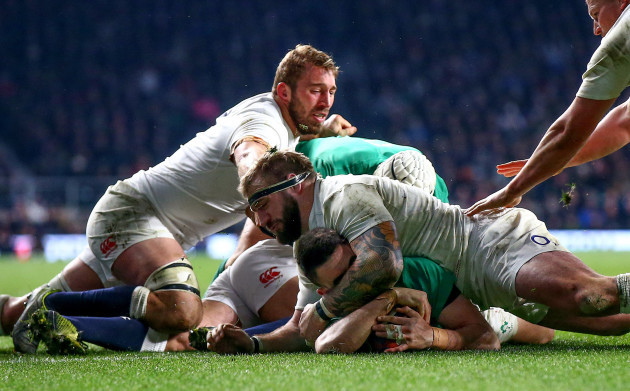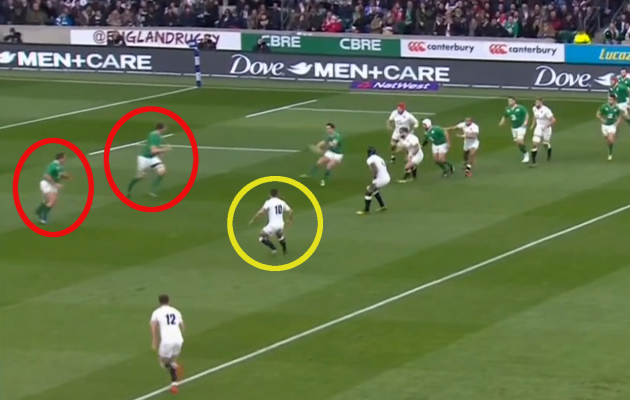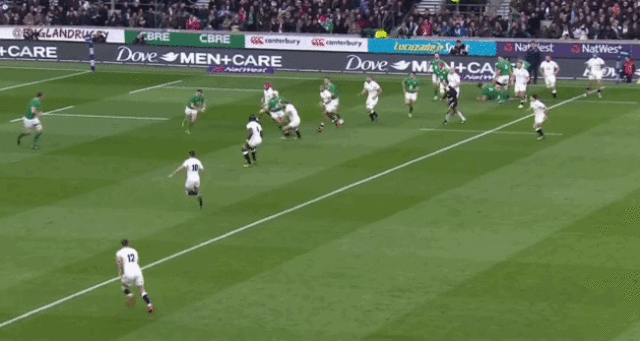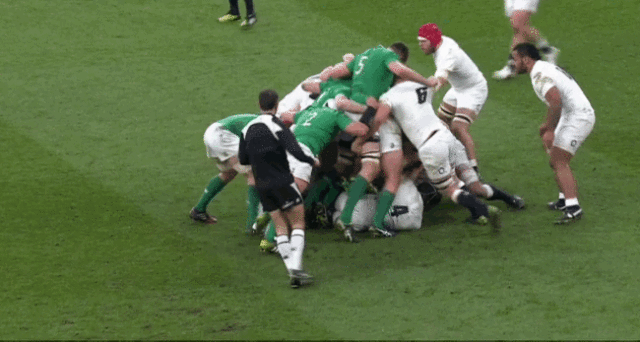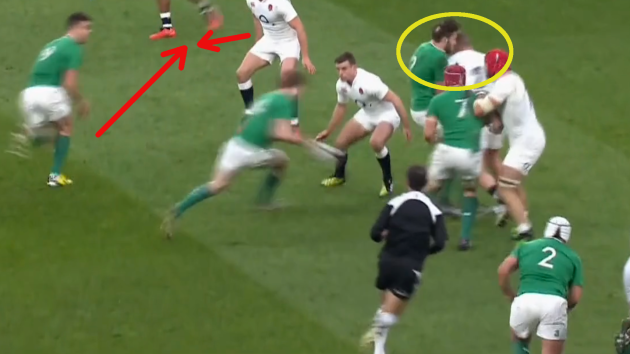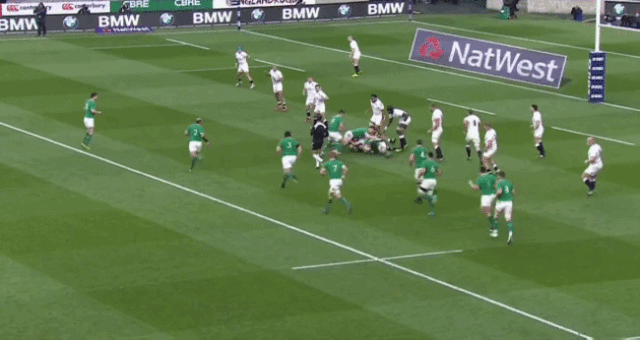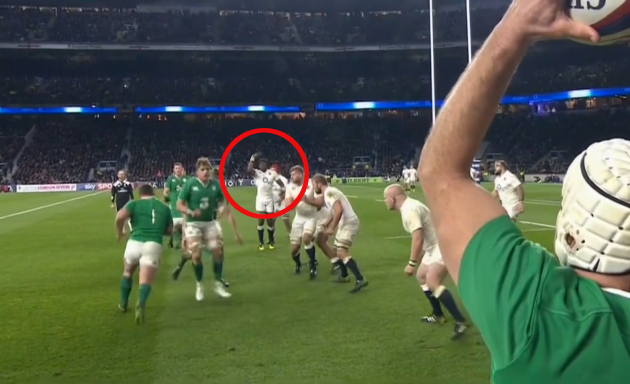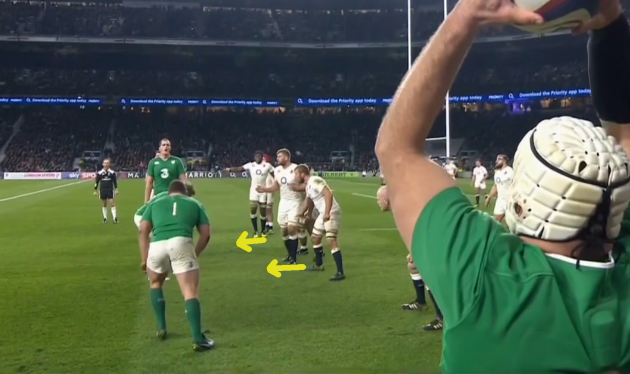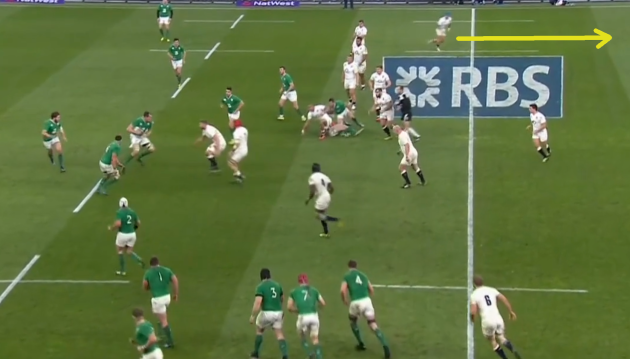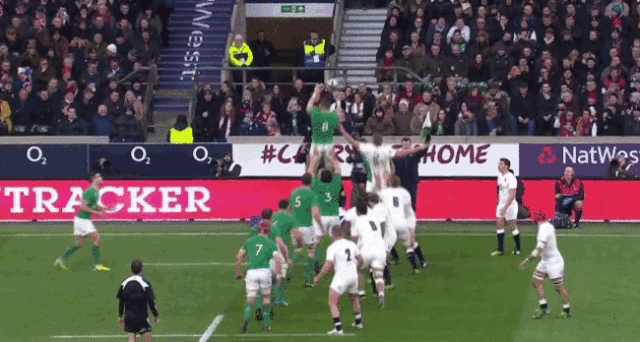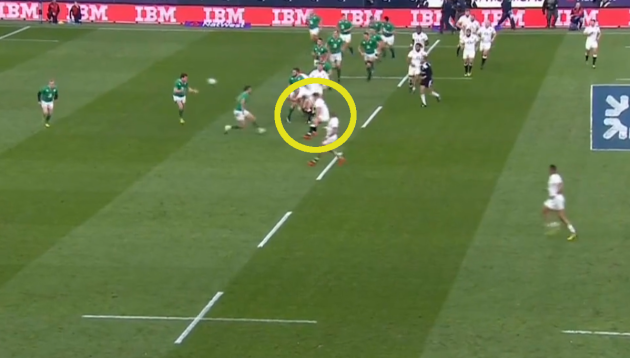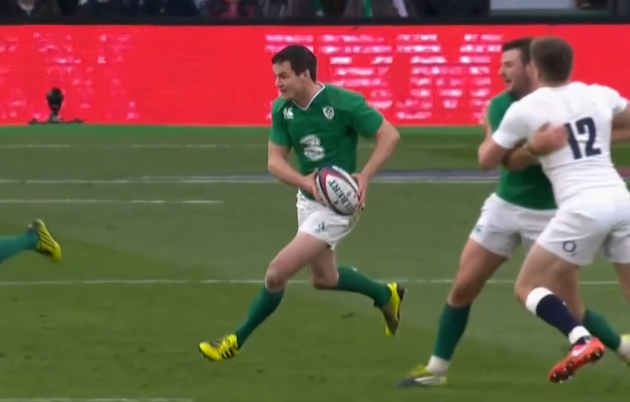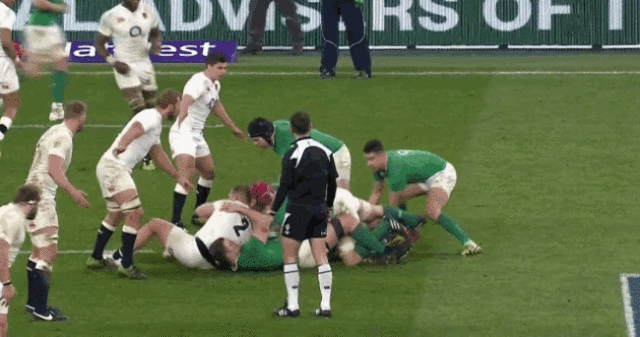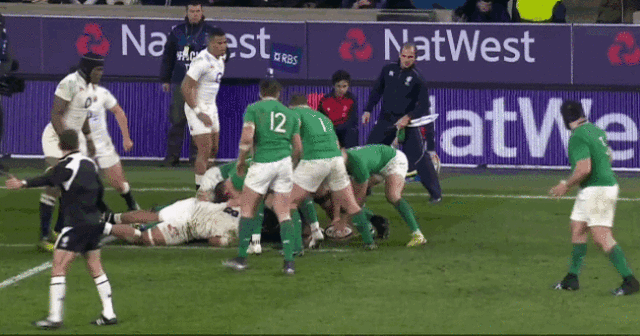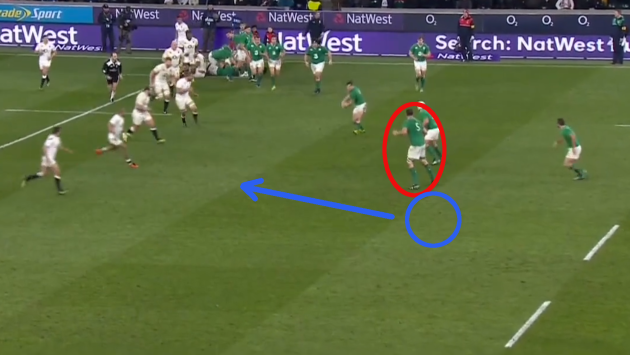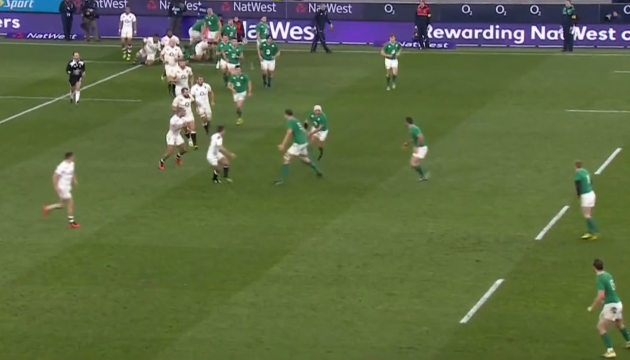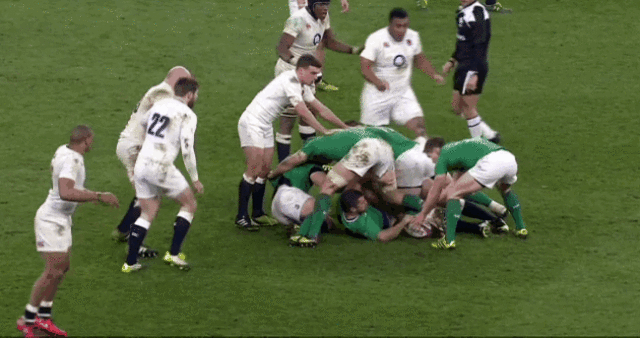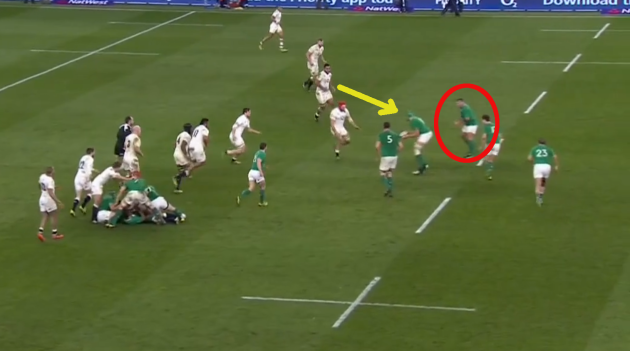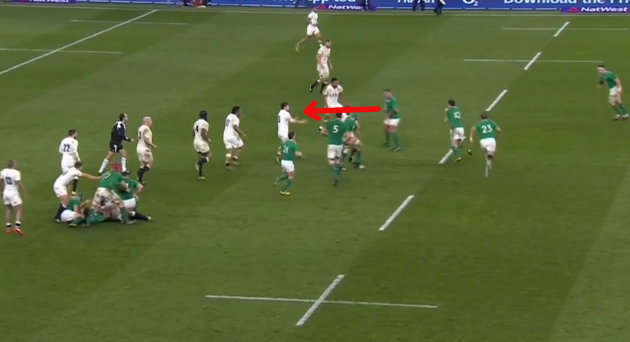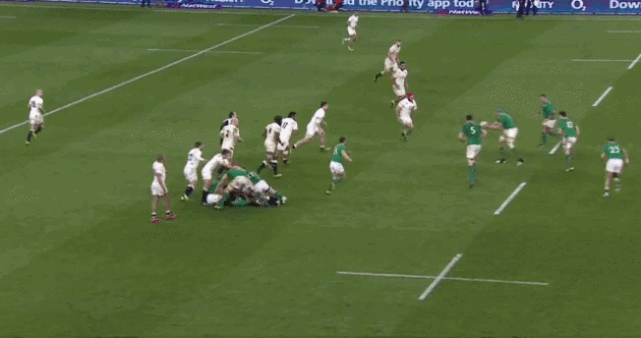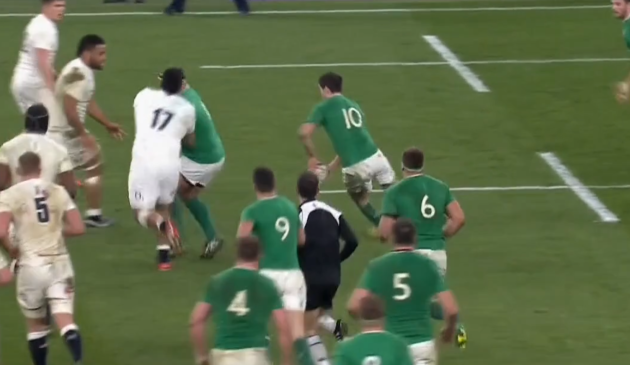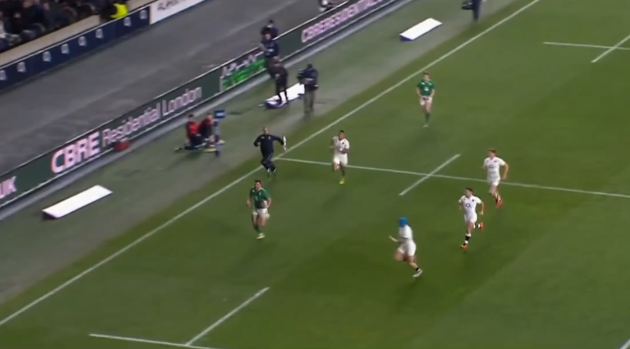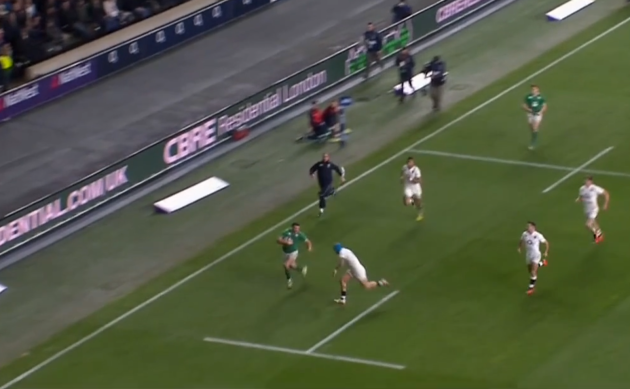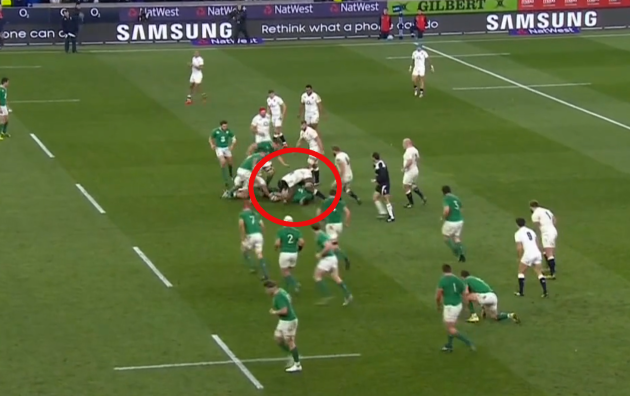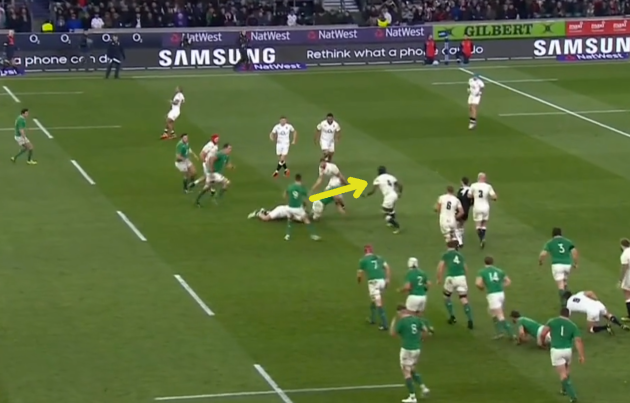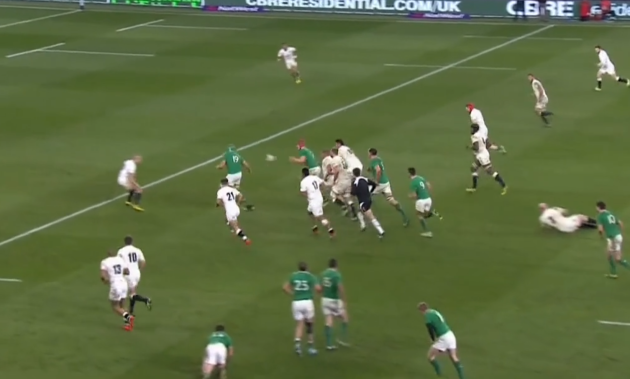Updated at 21.30
WITH SEVEN CLEAN linebreaks and 24 defenders beaten [more than anyone else in the Six Nations last weekend], the raw attacking numbers look good for Ireland after their visit to Twickenham on Saturday.
However, a more pertinent figure at this point is the two tries Joe Schmidt’s side have scored in their opening three games.
While it’s extremely likely that Ireland’s try-scoring count will rise notably in the closing two fixtures of the championship, it has been an issue so far. With 35 in total, Schmidt’s side are also the lowest points scorers in the competition at this stage.
The numbers in the opening paragraph would suggest that – as against Wales when there were also seven linebreaks – Ireland have been opening the opposition up. Taking advantage of good chances and positive field position has been the problem.
In Twickenham, much of Ireland’s attacking game plan was focused on the wide channels and attempting to get around England’s defensive line with their passing game.
While that ambition and intent was encouraging for fans, Schmidt’s men need to make big improvements when they employ this style of play. There were absolutely positives in the attacking performance, but Ireland lacked their accuracy of old.
Skills under pressure
From very early in the game at Twickenham, we saw Ireland’s intent to run the ball out from deep in their own half. The standard of execution was set at a sloppy level.
The above comes after Ireland have gone ahead through Johnny Sexton’s first penalty and Eddie Jones’ men are almost certainly expecting Ireland to solidly and securely go about building towards an exit through their kicking game.
Ireland’s decision to run is strongly justifiable here. Anthony Watson is deep in the backfield, as are fullback Mike Brown and number eight Billy Vunipola. Ireland knew that trio would lie deep after restarts and their attack is built to exploit that.
If the transfer of the ball to Andrew Trimble on the far right edge is clinical, Ireland can make big gains here.
Ireland opt to play out the back of two forward runners in Devin Toner and Jack McGrath [circled in red], but that duo of decoys show very little in the way of animation.
This was something of an issue throughout for Ireland, in that their decoy runners often didn’t look like viable options to receive the ball. Schmidt preaches the fact that everyone is an option no matter what the call, but it’s quite clear where the ball is going here.
George Ford [yellow] is never really interested by either Toner or McGrath and can make a good read. These are minor details, but even Toner and McGrath adding a little extra pace to their running line, with their hands up, can add a moment of indecision for Ford.
As a result of the programmed play, Ford is able to apply pressure on Rob Kearney and we see a breakdown in the fullback’s skills as he throws a poor pass over the head of debutant Stuart McCloskey.
With Farrell having made a good read to shut down the space in front of McCloskey early, Ireland’s opportunity to get the ball to Trimble in space and make some big gains is wasted.
That animation off the ball and skill level on it have been hallmarks under Schmidt both with Ireland and Leinster, but the accuracy does seem to have slipped this season.
We see a similar breakdown as Ireland look to run the ball out from deep in the clip above, with Johnny Sexton firing a pass to McCloskey barely a metre away from him.
Again, the idea to take England on in a four-on-three situation down the blindside is sound, but the execution is extremely poor. In fact, England very nearly score with the ensuing period of attacking pressure, only a knock-on in a tackle from Sexton on Ford saving Ireland.
McCloskey is perhaps a hint too flat to Sexton and will feel he should have held the ball, but the sheer velocity on the pass from the out-half makes it a difficult one.
Ireland’s intention to play out from deep at Twickenham was certainly laudable and targeted genuine opportunities, but when it’s not matched with accurate skill levels the danger is obvious.
France flashbacks
The fact that Ireland invited England back onto them in the first half meant their forays into more usual attacking territory were few and far between before the break.
When Ireland did get into good positions, the issues that cost them dearly in the first half against France were evident once again.
Above comes one strong example of that, as Ireland make another basic error to crush any opportunity of creating a scoring chance. This is in the 21st minute of the game with the scoreline at 3-3, and Ireland keen to win a penalty at the very least.
Ireland’s initial mauling effort breaks down, but they play away to the left and the thinking is once again sharp.
As Josh van der Flier breaks off the back of the maul, McCloskey runs a straightening line and manages to get a block on Dylan Hartley [yellow circle].
At the same time, scrum-half Murray arcs away from van der Flier and manages to attract inside centre Farrell [red]. The result is that Trimble is left with a direct one-on-one with the smallest England defender on the pitch, Ford.
A strong gainline is very likely, therefore providing Ireland with good front-foot ball to ask more questions of England. However, Trimble takes his eye off the ball and puts it to deck.
Above, we see Ireland’s very first foray into the England 22 and again it’s a tale of poor execution.
Schmidt’s side actually get picked off by the brilliant George Kruis at the lineout 10 metres out from the England tryline, but excellent battling by CJ Stander allows them to regain possession as the contest goes to ground.
Ireland move into their standard one-out routine in the opposition 22 thereafter, but it’s another poor pass that ends the passage.
This time it’s Murray who fires the ball over the head of captain Rory Best and the hooker fails to hold it. Again we should note that Ford is the defender directly in front of the intended Irish ball carrier; a gainline opportunity.
Instead, the skills break down and once again England are able to launch a counter that puts serious pressure on Ireland in scrambling back. Only Farrell coming offside at the next ruck allows Schmidt’s side off the hook.
The conditions in Stade de France excused some of the handling inaccuracies against France, but Ireland have to continue to hold themselves to the highest standards.
Set-piece
Before we go any further, the lineout issues Ireland suffered in Twickenham need to be underlined. Missing lineouts in the opposition 22, or even their half of the field, must go down as spurned scoring opportunities.
Simon Easterby’s pack struggled greatly out of touch in London, as Kruis and the exciting Maro Itoje did a fine job on them. We’ve already seen above one of Kruis’ steals as he simply holds his ground, reads Stander’s movement and gets up ahead of the Ireland flanker.
Note too the clapping of Itoje at the tail of the line in the example above. The 21-year-old was at this sort of thing throughout the game.
Watch Itoje again in the clip above, as Ireland’s lineout breaks down in the England 22 just two minutes into the second half.
The promising Saracens lock is actually signalling for Best to throw the ball to him, inviting the Ireland hooker to release it to where he has made a strong read and feels he can get up ahead of Donnacha Ryan.
It’s also worth noting how England close the one-metre gap here, inching close to Ireland with barely perceptible steps that the match officials clearly don’t notice.
Best and Schmidt both alluded to England “squeezing” the lineout after the game, but commenting on it at that stage is pointless.
If Ireland feel the opposition are infringing, they need to have the strength and leadership to actually stop play and highlight it to the referee here. Paul O’Connell certainly wouldn’t have accepted anyone squeezing the one-metre gap, and others have to learn to be more imposing and streetwise here.
As with so many of the incidents we look at in this piece, England deserve major credit. Itoje and Kruis read the lineout brilliantly all day and got up to contest fiercely through the game.
Their efforts are helped by a poor throw in this instance too, as the ball fades off to the right after leaving Best’s hands and makes it all the more difficult for Ryan to win in the air.
With the scoreline at 21-10 and 13 minutes still remaining for Ireland to build a comeback in the instance above, another lineout failing costs them.
This time replacement Rhys Ruddock does win the ball in the air, but then loses it as he comes down. Itoje isn’t entitled to grab at the Ireland flanker’s arm as he does in this case, but it is loose from an Irish point of view.
Losing O’Connell was always going to be huge for Ireland this season in the lineout, but Easterby and his forwards will need to fix these issues as they move forward.
Caught in two minds
Sometimes when Ireland pursue a game plan that involves wide patterns, retention of possession through handling and the running from deep we saw in Twickenham, they can become overly focused on the pre-defined ideas.
Schmidt wants good decision makers on the pitch and much of the time gets exactly that. However, there are also times when Ireland are too slavish to those pre-agreed tactics, be they kicking tactics or running tactics.
We get one example from last weekend in the clip above, as another Ireland maul attempt makes little ground and they opt to play off it to the left with a dummy loop play that sees Henshaw hitting Kearney on a short line.
The better option in this instance would perhaps have been to return the ball to Sexton, but that’s not the point here.
Ireland don’t make the gainline on that first carry after set-piece and so, the English defence is going to be moving forward. It’s only the second phase into the attack, but already Ireland look confused as to what comes next.
Murray looks left for Sexton, but the Ireland out-half [circled in yellow] is indicating for the Munster man to take play back to the right-hand side of the ruck.
Murray swivels his head to find a carrying option, but Toner and Stander are actually still in the process of retreating from the initial maul.
Toner receives the ball standing still and gets grounded by Kruis, allowing James Haskell to instantly threaten. Ireland panic and Stander comes right in from the side to concede the penalty.
That’s an attacking effort that directly costs Ireland points, and this was perhaps an occasion when Ireland should have accepted their losses and kicked the ball deep into England’s half.
We don’t have an image of the backfield here, but the manner in which Jack Nowell retreats rapidly even as the ball is being moved back to the right suggests fullback Mike Brown is a little isolated.
Is this a moment for Sexton to use one of his excellent long, raking kicks looking to bounce into touch? It’s not exactly the ideal position for him to kick from, but the option Ireland do take is far more dangerous and they invite more England pressure.
Set-piece spark
Ireland were unlucky to be called back with their best set-piece strike of the first half, with Henshaw penalised for what referee Romain Poite perceived as obstruction on Farrell.
As Scotland did against England with some success, Ireland look to isolate Farrell in the inside centre position directly from the set-piece.
With McCloskey acting as first receiver, they run a really simple screen play behind Henshaw to Sexton.
It’s Farrell who initiates the contact with Henshaw in this instance, as we see above, and it’s the England centre’s misread that is the cause of the collision.
Attacking players are entitled to run decoy lines, of course, and we can see below that Farrell has completely bought Henshaw’s direct line well before there is any contact between the pair.
Farrell has sat right back onto his heels in order to make what he’s read as a tackle on Henshaw, but the ball goes out the back.
What probably costs Henshaw and Ireland is the outside centre’s little grasp at Farrell after they come together.
That’s the picture Poite sees; Henshaw’s arms up around Farrell’s torso and he immediately calls a halt to play for the penalty.
Ireland have gotten away with this sort of thing countless times through the Schmidt era and Poite certainly missed other instances of it in this game.
As Schmidt has alluded to, it’s odd how these things go against a team when they are on a poor streak of results.
Linking
A huge part of Ireland’s second-half attack against England was based around their use of forwards to pass out the back door in a typically rugby league style.
We see the shape in action above, as McGrath finds Sexton to burst through a gap in the English defence.
These shapes were a feature of Ireland’s pre-World Cup games, particularly the win over Scotland at the Aviva, but we haven’t seen a huge amount of them since then. Every team in the world uses this type of play in attack, but Ireland have been sparing in their application.
In the second half against England, this was almost the default method in phase play and Ireland did get some good results from using their forwards to pass the ball, as in the Sexton example above.
That said, there are certainly improvements Ireland can make to be more threatening with these plays in the future. Often, their use of the ball out the back door was predictable and allowed England to put them under pressure.
Go back to Sexton’s break above and note the actions of Stander to McGrath’s left and ahead of Sexton. He’s looking for any way to interfere with the defence and he gets the slightest of nudges on Dan Cole just to wrong foot the tighthead prop, who Sexton then beats.
Above, we get an example of Ireland being ineffective and predictable with a similar play.
On this occasion, they use the play one pass out the line, with Best accepting the ball from first receiver Sexton and then shifting it behind Toner to Kearney.
One of the issues here is that Best is never really a carrying threat himself. The primary thing when he gets the ball should be that England’s defenders view him as a possible carrier, but the body shape is non-threatening in this instance.
Outside Best, it’s a similar story. Toner is very flat to the hooker and is almost standing still as the play swings into life. At no point does the lock look like a viable receiver of a short pass from Best, as he is intended to be in this instance.
Had Toner been able to take even one step wider and deeper, he may have been able to generate some forward momentum and appear as a genuine threat to the English defence.
He doesn’t want to get into a position where he blocks Best’s option to go out the back, but this shape is constructed with the idea that there are multiple options. In this case, there is only one and we can see how easily Ford is able to read it and push up outside Toner.
Kearney is then forced to duck back inside as Ford pressures him. Had Best and Toner been able to create even a hint of indecisiveness in Ford and Jonathan Joseph inside the out-half, asking questions with their running lines and body language, that may have forced the English defenders into biting down just a hint.
If that happened, Ireland were on to shift the ball through Kearney and really stretch the English with width.
We see something similar in the incident above, as Ultan Dillane is used as the passing hub on this occasion.
Haskell commits to rushing up on the Connacht lock this time, so there is at least one English defender buying into Ireland’s deception as Dillane releases a typically accurate pass out the back door of Nathan White.
White, however, is never a realistic target in this instance. His hands are down by his sides and he is very static.
Strong animation here, or the addition of a little more width before running a strong, aggressive line off Dillane’s shoulder, might have invited Billy Vunipola into biting in on him a little and leaving Ireland with a really favourable 5-on-3 on the outside edge if Sexton could get to Vunipola’s outside shoulder.
Even if he’s not going to interest Vunipola, White must look to be a nuisance to the defensive line even after the ball has been shipped on by Dillane.
If White can advance beyond Dillane on that hard running line we have spoken of, there’s every possibility he can get a nudge in on Jack Clifford, now the defender inside Vunipola, as we see above.
If White can do that, it leaves Ireland with a genuine 5-on-3 and a disconnect in the English defence. Even if Ireland don’t make a big bust up the right, it will almost certainly allow them quick ruck ball after the tackle.
Instead, Clifford is free to hunt across the pitch on the inside and, as we see above, he wins a turnover penalty for England.
Taking chances
Funnily enough, it was some brilliant work off the ball by replacement tighthead prop White that allowed Ireland to cut through the English for Henshaw’s big opportunity in the second half.
Sexton runs his classic loop play on the 10th phase of an Irish attack from deep and it’s White who receives and returns the ball to the out-half.
Crucially, White stays big after returning the pass to Sexton and we see below that he continues his line forward to block off Mako Vunipola. Intelligent play.
Sexton does typically well to draw in fullback Brown and hit Henshaw supporting him on his right shoulder.
Schmidt has said the Ireland centre was agonising over this scenario after the game, wondering if he should have dived for the corner early, attempted to step back inside Nowell or keep the ball in two hands as he strode for the line.
It’s at the point above that Henshaw needs to make his decision, just over 10 metres out from the tryline but with Nowell appearing into his line of vision. Henshaw opts to switch the ball into his right hand and fend Nowell with his left.
The fend misses its target, however, as Nowell dives into the tackle and bats it down with the force and speed at which his body is moving.
Only Henshaw himself can analyse and learn from this with 100% clarity, and he will certainly wonder if he could have used his considerable weight advantage over Nowell to better effect.
The England wing certainly had Henshaw for pace, but a strong dropping of Henshaw’s weight into the Exeter man as he stepped off his right foot and into Nowell may well have knocked him off balance and allowed Henshaw the space to finish in the corner.
Strike runners
Among the encouraging signs for Ireland in this fixture at Twickenham was the manner in which their young players were able to demonstrate an ability to beat defenders.
Henshaw produced a big bust from nothing just before half time, stepping inside Farrell with that excellent footwork of his and then bursting past flailing tackle attempts from Robshaw and Billy Vunipola to make more than 30 metres for Ireland.
In behind the English defence, opportunity beckoned but Itoje was awarded a penalty at the very next ruck.
We can see above that Itoje has his hands on the ground, and is therefore technically off his feet, but Ireland have benefited from many decisions like this one in the past.
Instead, their regret might be around how they failed to deal with the instant threat posed by Itoje. Herein, we see one of the ‘dangers’ of the tip-on pass as Stander becomes isolated from Toner after accepting the lock’s pass.
With Toner struggling to make up ground after Haskell gives him a slight nudge post-pass, the onus is on Murray to hit the ruck. His primary duty is to pass the ball from the base, but sometimes needs must and he is in a position to clear out Itoje here.
Instead, he stands off and the ball is poached.
Henshaw wasn’t the only man making big plays in attack for Ireland, with McCloskey’s growth into the game early in the second half particularly encouraging for Schmidt’s men.
Above, McCloskey takes advantage of Itoje being tight to the ruck to power past the England lock with a nice left-handed fend and then bounces off scrum-half Ben Youngs for further gains, fighting into contact with Robshaw.
There weren’t a huge number of similar carrying opportunities for the Ulster centre throughout the game, but he showed that his athletic ability can transfer into the Test arena.
Ditto for Dillane.
The replacement lock’s big linebreak came against a tiring English defence, but showed the value that raw, energetic, determined youth can bring to a team.
The Connacht man is desperate to add physicality off the bench for Ireland here and looks like he actually expects to break the line, rather than just perform a carry to set up a ruck.
Dillane’s explosiveness is also evident here, although he will reflect on a missed opportunity behind the English line.
The break is stunning of course, but as we can see above, he delivers his pass to van der Flier before he has actually drawn in Brown.
As a result, the England fullback is able to cover across and scrag van der Flier. There is a a sublime offload from the Leinster flanker, but at that point Vunipola has worked back [he was superb in defence too] and hauls Dillane down.
Though Watson was covering across from wide to Ireland’s right, it’s almost certain that van der Flier would score here if Dillane is able to take Brown out of the game with his draw and pass.
More growth required
We saw with Murray’s try [lineout platform] and the van der Flier effort that wasn’t awarded [five-metre scrum] just how effective Ireland can be from close range against any opposition.
That has been a longstanding strength, but their ability to stretch and break down teams from further out the field remains a work in progress. With 14 linebreaks against Wales and England in total, there are promising signs in that regard, although Ireland need to find a ruthless edge in behind.
There is lots of positive intent and the thought processes behind what they are doing remain strong, but the execution has been lacking.
That’s the most jarring aspect of Schmidt’s team at present. The previously Six Nations-leading standards for precision in passing, animation, kicking and choice of running line are not at a peak at present.
There are many flashes of the previous high quality of course, but consistently applying those standards has been a problem. It’s a challenge for Schmidt to now ensure that his players do not accept their current inability to execute consistently.
- This article was updated at 10.48 on 2 March to correct an error that stated England had gone 3-0 ahead early in the game.
